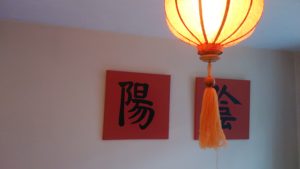


ACUPUNCTURE AND ACUTE FEBRILE DISEASE
When contemplating acupuncture and acute febrile disease treatment, the main source from classical Chinese medical literature is Yi Tian Shi. He was a Qing dynasty physician working in the eighteenth century. Yi Tian Shi developed a theory of treating infectious diseases at a time when they were rampant in China. In his work Wen Re Lun (On Febrile Disease), he was building on and developing theories that went as far back as the Nei Jing (the oldest medical text in the world). His theories are concerned with the contraction of warm pathogens, such as might infect the digestive tract or the respiratory system, which are seen as penetrating through four layers of the body. It is interesting to remember when looking at acupuncture and acute febrile disease that George Soulie de Morant, who very much pioneered the development of acupuncture in the west, was first attracted to acupuncture when he saw its effectiveness first-hand during infectious diseases outbreaks in China.

The theories of traditional Chinese medicine and acupuncture and acute febrile disease treatment
For acupuncture and acute febrile disease treatment and diagnosis, the first and outermost level is referred to as the Wei level. Yi Tian-Shi is speaking specifically about pernicous diseases, rather than more common colds and viruses. The main symptoms at this level are fever, aversion to cold and wind, cough, and a sore throat. The pulse will also have a specific quality referred to as a floating quality. Disease patterns such as urinary tract infections, tonsilitis, measles, and early stage pneumonia might be involved in such a presentation. The aim of treatment is to expel the pathogen from the outermost layer of the body.
The next level is referred to as the Qi level and involves a struggle between a strong pathogen and strong bodily defences. From here, depending upon the nature of the pathogen, it can affect different parts of the body, most commonly the stomach and the chest. There will be high fever and no aversion to cold now, rather aversion to heat. As fluids are consumed by the heat, there will be extreme thirst. When it comes to diagnosis, we expect to see everything as big – a big sweat, big fever, big pulse, and big thirst. It is the lack of aversion to cold that tells us that the pathogen is no longer on the body’s surface.
The next two levels indicate severe disease patterns. Firstly, we have what is referred to as the Ying level, which will encompass conditions such as meningitis, encephalitis, and lobar pneumonia. These are diseases that all require hospitalisation, but at the time Yi Tian Shi was writing, acupuncture and Chinese herbal medicine were the primary treatment methods. Children are most commonly affected by diseases that penetrate to the Ying level, when there is now a marked effect on the functioning of the body’s organs. We will see symptoms such as insomnia, delirium, restlessness, clouded mental faculties, skin eruptions, and possibly convulsions and skin eruptions.
The deepest level of pathogenic penetration is called the Xue level. This involves all the previous signs and symptoms plus distinct dark skin eruptions, skin that is hot to the touch, mania, bleeding (eg epistaxis, blood in the stools, or haemoptysis), a red and peeled tongue, and a rapid and fine pulse.
There are different treatment protocols relevant to all these three levels, and different acupuncture points will be employed depending upon assessment of how deep the acute pathogen has penetrated.
In practice, in this country acupuncture is mostly used to treat chronic conditions. Wonderful advances in western bio-medical science has lead to effective treatment for many, although sadly not all, of the conditions that would fall into the categories discussed here. Perhaps there is also scope to consider acupuncture and acute febrile disease treatment as an option to enhance western medicine protocols or to use as an option in an age of increasing drug resistance. Yi Tian Shi’s work remains of interest and does have some useful practical implications. Understanding how pathogens penetrate through the defensive layers of the body is an essential part of the training of an acupuncturist in the theory of traditional Chinese medicine.
To learn more about the history of acupuncture practice, click here.
To find out more about Yi Tian Shi from other sources, click here.


